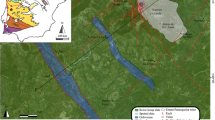Abstract
Vein-related data have been collected around the giant Rio Tinto orebody in southern Spain within the root zones of the massive sulphide deposits. Here, we report the main results of this study, concerning the geometry of the stockwork and the conditions of formation. Although field and thin-section studies have shown that a wide range of vein configurations exist, from micro cracks (fluid-inclusion planes) to large paleo-flow channels, two groups seem to dominate. The first corresponds to small, constricted micro cracks and capillary-flow channels, now mainly filled with quartz, whereas the veins of the second group have large widths, are continuous over several meters and are filled with quartz and sulphides. Most are tension veins and only very few (<0.1%) show evidence of shearing. The pyrite-dominated variety (i.e., pyrite > quartz) tends to post-date the quartz-dominated veins (quartz > pyrite). The vein-thickness and -spacing distribution is modal rather than logarithmic, and their densities are not fractal, but are characterized by a Poisson distribution. From the immediate sub-surface zone to more than 100 m below the base of the massive sulphide deposits, most hydrothermal quartz-sulphide stockwork veins are sub-parallel to the base of the massive sulphide deposit. The assumption that the base of this deposit corresponds to a paleo-horizontal plane, implies that most veins were sub-horizontal. This is particularly evident for small veins, but the larger ones can be strongly oblique to the base of the deposit. The hydrothermal fluids that generated the massive sulphide deposits and underlying stockworks, were very saline and probably underwent sub- or super-critical phase separation in the root zones of the system. This phase separation was the probable mechanism producing the periodic over-pressures of at least 20 MPa that were necessary to generate the sub-horizontal veins of the stockworks.
Resumen
(translated by E. Pascual) Se han recogido datos relacionados con las venas hidrotermales en las proximidades de la mineralización gigante de Riotinto, en la zona de raíz de los sulfuros masivos. Describimos aquí los principales resultados de este estudio, referentes a la geometría del stockwork y sus condiciones de formación. Aunque los estudios de campo y en lámina delgada han demostrado que hay un amplio rango de configuraciones de venas, desde microfracturas (planos de inclusiones fluidas) hasta grandes canales de paleoflujo, dos grupos parecen dominantes. El primero corresponde a pequeñas microfracturas y canales de flujo capilar, rellenos de cuarzo, en tanto que las venas del segundo grupo son mucho más anchas, continuas a lo largo de varios metros y rellenas de cuarzo y sulfuros. La mayor parte de venas son de tensión, y sólo algunas (<0,1%) muestran cizallado. La variedad en que predomina la pirita (es decir, pirita>cuarzo) tiende a ser tardía respecto de las venas en que domina el cuarzo (cuarzo>pirita). La anchura y distribución espacial de las venas es modal más que logarítmica y sus densidades no son fractales, sino que se caracterizan por una distribución de Poisson. Desde la zona inmediatamente subsuperficial hasta más de 100 m bajo la base de los sulfuros masivos, la mayor parte de las venas hidrotermales del stockwork con cuarzo y sulfuros son subparalelas a la base del depósito de sulfuros masivos. La suposición de que la base de éste corresponde a un plano paleohorizontal implica que la mayor parte de las venas sean subhorizontales. Esto es particularmente evidente en el caso de las pequeñas, pero las mayores pueden ser fuertemente oblicuas a la base del depósito. Los fluidos hidrotermales que generaron sulfuros masivos y los stockworks infrayacentes fueron muy salinos y sufrieron probablemente separación de fases sub- o supercrítica en la zona de raíz del sistema. Esta separación de fases fue probablemente el mecanismo que produjo las sobrepresiones periódicas de al menos 20 Mpa necesarias para generar las venas subhorizontales de los stockworks.
Similar content being viewed by others
Author information
Authors and Affiliations
Additional information
Received: 10 Jaunary 1996 / Accepted: 10 April 1997
Rights and permissions
About this article
Cite this article
Nehlig, P., Cassard, D. & Marcoux, E. Geometry and genesis of feeder zones of massive sulphide deposits: constraints from the Rio Tinto ore deposit (Spain). Mineral. Deposita 33, 137–149 (1997). https://doi.org/10.1007/s001260050137
Issue Date:
DOI: https://doi.org/10.1007/s001260050137




